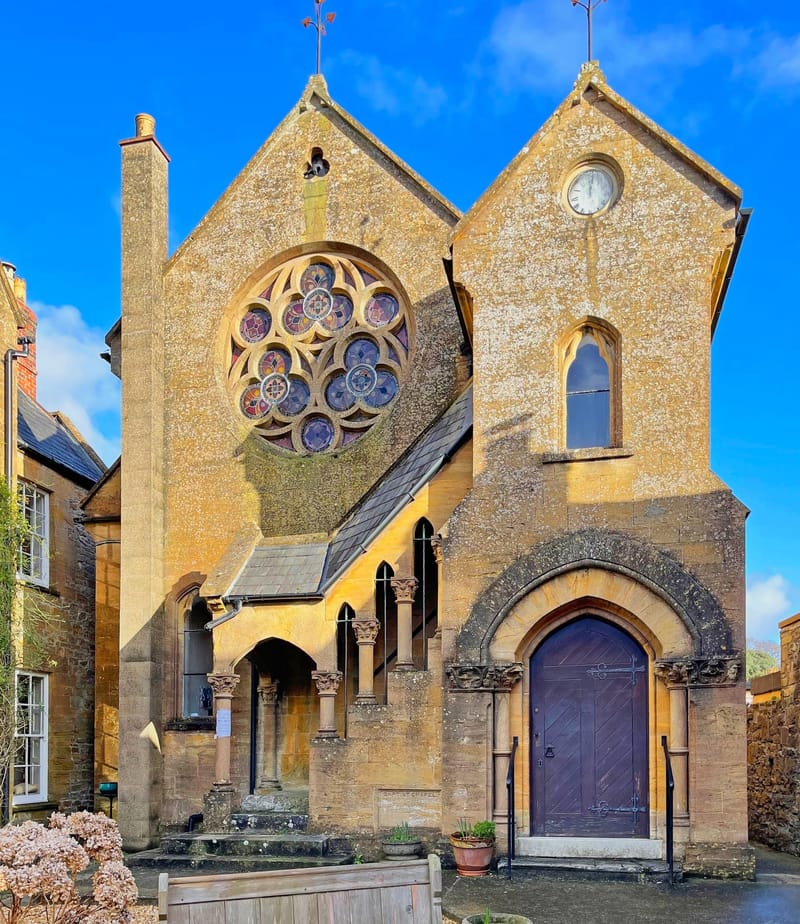Montacute Baptist Church

Work in progress!
Ref also https://www.montacutebaptistchurch.org.uk/anewhistory.htm
The Baptist tradition in 1656
The Baptist Church in Montacute has a deep connection to early nonconformist practices. According to the Victoria County History (VCH), Baptists were meeting in the village as early as 1656; for this date VCH refers to "Confessions of Faith of several Churches of Christ in Somerset". Although specific references to Montacute are scarce in records like the "Confessions of Faith", Montacute Baptist Church's history page cites Thomas Budd’s attendance at a Baptist meeting in Bridgwater in 1656 as the first mention of the tradition in the village. British History Online says Thomas Budd, a former Rector of St. Catherine's Church, became a Quaker and settled in Ash. In 1657, he hosted two Quaker meetings in his orchard, attended by hundreds. Both were violently disrupted — the first by local priests and "a great company of rude people with long staves and pikes"; the second by soldiers. Budd and the preacher Thomas Salthouse were arrested but later released. In 1661, Budd was imprisoned for refusing to take the Oath of Allegiance to Charles II and died in Ilchester Gaol in 1670.
Why Nonconformism Was Popular in the West Country
Several factors explain why Nonconformist sects like the Baptists gained support in the West Country:
1. Resistance to Centralized Authority: The rural West Country had long been skeptical of centralized political and religious control from London. Local communities valued religious independence and viewed the Anglican Church’s dominance as foreign and oppressive.
2. Economic and Social Appeal: Nonconformist movements, especially the Baptists and Quakers, appealed to the working classes, including weavers and small farmers. These groups, who had more independence and less economic power, found the Nonconformist emphasis on personal faith and community support appealing. For many, the Nonconformist promise of religious freedom and rejection of the hierarchical Church of England resonated deeply with their lives, as they felt disconnected from the elite landowning class, which was closely aligned with the Anglican establishment.
3. Escape from Persecution: The 1662 Act of Uniformity forced clergy to conform to the Church of England, leading many Nonconformists to move to rural villages like Montacute where they found more sympathetic communities.
4. Preaching in Local Dialects: Unlike the formal sermons of the Anglican clergy, Nonconformist services would have been led by a mix of visiting preachers and local lay leaders who were often locals themselves, so their dialects and their messages were more relatable to their congregations.
5. Meeting Houses and Local Leadership: Originally catering for a scattered rural population, Nonconformists often met in small, personal chapels or homes, making their services more accessible.
Nonconformism and the 1685 Monmouth Rebellion
During the Monmouth Rebellion of 1685, Royalist Sir Edward Phelips III led a militia against the rebels. While Monmouth’s forces briefly captured Axminster, Phelips' militia played a crucial role in pushing them back at Chard. It would have been difficult for Montacute villagers to support the rebellion due to Phelips' strong authority in the village. Even though some Nonconformists, including Baptists, might have been initially sympathetic to Monmouth due to his promises of religious tolerance, the political and social pressure from Phelips’ Royalist stance would probably have deterred open support.
Jump forward to 1758
VCH and the Montacute Baptist history go on to say the tradition was revived in 1758 when a local weaver, Samuel Geard, hosted Anabaptist services in his home (possibly in the Borough in Montacute), and the Geard family provided continuity for Montacute's Baptist tradition. In around 1770 a barn was used for services by deacons of the Yeovil Baptist Church, then in 1824 Jesse Geard leased a cottage (next door to the property that would become The Shoemakers Arms) for Particular Baptists. The first chapel was built on its site, and they also acquired the Shoemakers Arms.
As the congregation grew so did their buildings, culminating in completion of the present-day church on South Street by 1880. Union activist George Mitchell who had "learned (his) ABC at the Baptist Sunday School, Montacute" was amongst those who helped financially, and it was designed by architect Morgan H. Davies in the Early English style. Built of hamstone, it has a stunning rose window and a Gothic-style pillared open-air covered stairway leading to an upper floor in the church.
Next up: the Rev Henry Hardin.